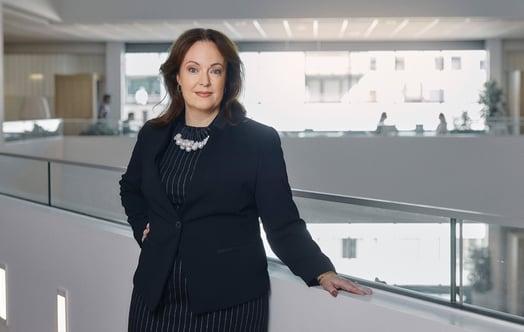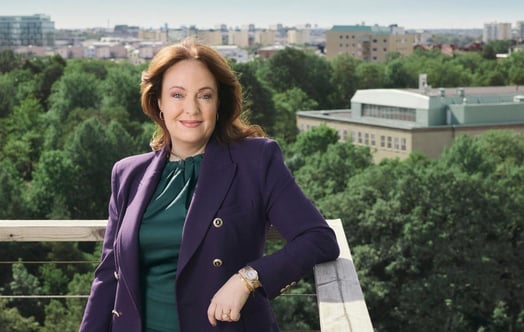Strong contribution from fossil-free generation, but the heavy storm 'Alfrida' in Sweden cost Vattenfall SEK 850 million in the first quarter.
Video player requires marketing cookies.
To view this content please click here to allow marketing cookies.
Watch the video interview with Vattenfall's CEO Magnus Hall and CFO Anna Borg about the Group's results for the first quarter of 2019.
Vattenfall's underlying operating profit rose somewhat during the first quarter, from SEK 9.4 billion last year to SEK 9.7 billion. The increase is the result of a good contribution from fossil-free energy generation, primarily from wind power, hydro power and nuclear power. Profit for the quarter was SEK 6.4 billion, compared with SEK 4.2 billion for the equivalent period last year.
Major costs after storm
However, the profit was dragged down by costs associated with Storm Alfrida. The storm, which hit Sweden on the night of 1-2 January, affected a total of 65,000 of Vattenfall Distribution's customers. The urgent repair work took three weeks, but the work of restoring the grid completely is still under way.
For Vattenfall, Alfrida meant increased costs of SEK 850 million during the quarter, roughly half of this amount being compensation for interruption of supply to affected customers, and half being repair costs. There may still be further costs associated with the storm.
"This has been a quarter with highs and lows. Storm Alfrida was the biggest single event. It made great demands on our resources and gave many customers a difficult time. For us, it meant that the grid had to be rebuilt from scratch in some cases, and this has cost us an enormous amount of money. At the same time, Vattenfall's efforts have been met with praise by many people around us," says Magnus Hall, CEO and President of Vattenfall.
Higher electricity prices in the Nordic region
In the Nordic region, electricity prices were at a higher level than in the first quarter of 2018. This benefited the Power Generation segment, which includes, among others, hydro power and nuclear power. Admittedly, electricity generation fell somewhat in comparison with the same period in 2018 – lower reservoir levels and a damaged generator at nuclear power reactor Ringhals 2 affected generation. However, the higher prices compensated for this. In combination with a strong profit from trading operations, the underlying operating profit from Power Generation therefore rose from SEK 3.8 billion last year to SEK 5.4 billion during the first three months of the year.
Good contributions from Wind
Wind power also benefited from the positive price effects combined with added new capacity, and made a good contribution to this quarter's profit as well. The underlying operating profit from wind operations rose by SEK 0.4 billion to SEK 1.5 billion.
For the sales operations in Customers & Solutions, the higher electricity purchase prices had the effect of reducing the profit. On the other hand, higher purchase prices will be compensated for by price increases. In Germany, the customer base is growing, which results in an initial cost during the first quarter, but which contributes to increasingly profitable business in the future. The underlying operating profit was just under SEK 0.4 billion for the quarter, roughly SEK 0.6 billion less than the equivalent period last year.
The Heat segment had an underlying operating profit at the same level as last year, SEK 1.5 billion. The market conditions for Heat remain difficult, especially in the case of electricity generation, with high prices for emission allowances and fuels.
"In order to achieve our Group targets, we need to focus our efforts, our resources and our time. We also need to continue to keep a close eye on our costs to ensure that we can deliver strong profits from all our business areas," says Vattenfall's CFO Anna Borg.
Vattenfall's quarterly report, Q1 2019
Important events, January–March 2019
- Major disruptions after the storm “Alfrida” with related costs of SEK 850 million.
- Generation drop partly due to lower generation at Ringhals 2 where a generator is now being replaced.
- Acquisition of DELTA Energie retail company in the Netherlands.
- Generation at the Hemweg 8 coal-fired power plant in the Netherlands to be discontinued at the end of 2019.
- Commissioning of 170 MW wind power and 6 MW solar power.
- Tender submission for the Hollandse Kust Zuid 3 & 4 wind power project in the Netherlands and a project in Dunkirk in France.
- The city of Berlin wishes to allocate the Berlin Energie concession for electricity distribution.
Financial development, January–March 2019
- Net sales increased by 13% (10% excluding currency effects) to SEK 49,552 million (43,860).
- The underlying operating profit amounted to SEK 9,673 million (9,359).
- The operating profit amounted to SEK 8,168 million (6,975).
- Profit for the period amounted to SEK 6,420 million (4,158).


